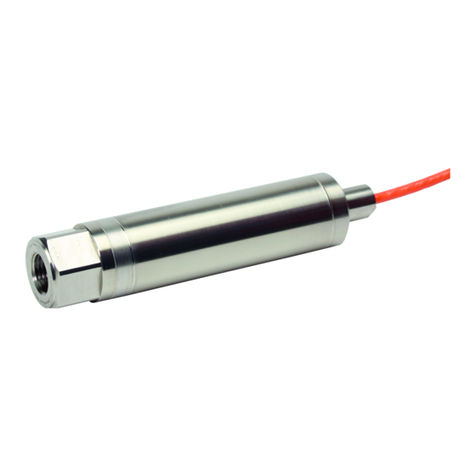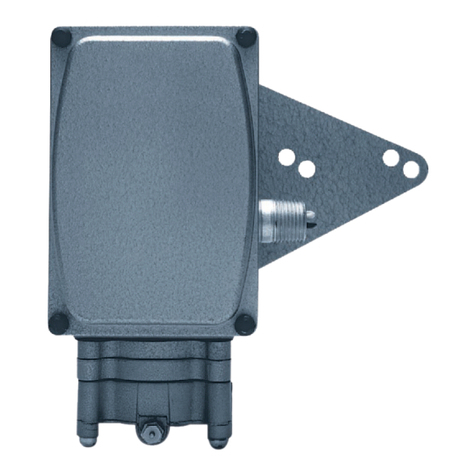
Masoneilan Model 4411 Electropneumatic Transducer Instruction Manual | 4
Copyright 2020 Baker Hughes Company. All rights reserved.
Under no circumstances should PTFE tape be used
for sealing the ttings as this tends to shred small
particles which may nd their way into the instrument
causing malfunctions.
The use of a soft setting anaerobic hydraulic seal is recommended,
(e.g. Loctite Hydraulic Seal 542). Follow the manufacturers
recommendations�
Do not use an excessive amount as this will not set
and could nd its way into the instrument.
If the air supply is not of adequate quality, the device performance
can be affected. Adequate quality can normally be achieved by
the use of air filter regulators.
Electrical Installation
The electrical connections should be made as shown in the
dimensional drawing Figure 1. The instrument is protected
against reverse polarity to –100mA, no operation is possible in
this condition�
The Model 4411 approximates a constant voltage load of 6.5
volts across the loop terminals, therefore it is essential that the
loop controller be capable of providing a constant current in the
range 4-20mA with an output voltage of at least 6.5 volts.
Voltage output controllers (e.g. variable voltage power
supplies) are entirely unsuitable for the Model 4411
and could severely damage the electronic circuits.
Important Note
The control electronics of the Model 4411 incorporate
precision electronics. The calibration of the unit may be
affected by very high voltage spikes. Consequently, in
environments where static electricity may be present ESD
precautions should be used.
Wiring And Cable Entry
These instruments must be installed in accordance
with local and national codes of practice, especially for
hazardous area installations. The instruments are fully
isolated from ground and therefore grounding is un-
necessary for functional purposes. However, ground-
ing may be necessary to conform to installation codes.
Note: It is strongly recommended that shielded cable or a
grounded conduit be used to achieve maximum RFI immunity,
if the installation has any risk of electromagnetic interference.
Conduit Entry
The instrument has twin conduit entry threaded 1/2" NPT. For
explosion proof installation, a sealed conduit gland conforming to
explosion-proof specifications must be used. A ground terminal
is provided both internally and externally and should be used if
ground continuity is essential.
The unit is supplied with plastic blanking plugs, which
must be removed before operation/calibration and re-
placed with a blanking plug conforming to the hazard-
ous area certication rating applicable.
Calibration
The instruments are designed for continuous operation without
the necessity for routine overhaul, with continuous monitoring,
adequate precautions and replacement of the filter no longer
than every 5 years.
The most common source of failure for pneumatic instrumentation
has been found to be inadequate air quality, allowing
contaminants to block internal orifices. Air filtering is included
within the instrument but cannot cope with sustained poor air
quality, which may ultimately lead to failure.
The recommendations in the Pneumatic Installation section
should be rigorously observed.
Note: These instruments are factory calibrated at a supply
pressure of 30psig (2 bar).
The instrument cover must be unscrewed to obtain access to
the trimpots�
Do not remove the instrument cover in a potentially
explosive atmosphere when the instrument is powered.
An accurate current source of 4-20mA and pressure gauge are
required. These should be of good quality with an accuracy of
0.1% or better. The current source should be checked to ensure
that it provides at least 6.5V at 20mA output compliance.
• Connect the instrument as described in the installation
section or the test-jack section below.
• Remove the instrument cover to gain access to the trimpots
and jack-socket.
• Set the current to 4.00mA – the instrument outlet should be
3.00+/-0.05psig (0.200+/-0.003 bar). Adjust the Zero trimpot
if necessary.
• For 6-30 psig output, the output pressure should be set to
6.00 ±.05 psig (0.400 ± .003 bar). Adjust trimpot as necessary.
• Set the current source to 20.00mA – the instrument outlet
should be 15.00 +/-0.05psig (1.00+/-0.003 bar). Adjust the
Span trimpot if necessary.
• For 6-30 psig output, the output pressure should be set to
30.00 ±.05 psig (2.00 ± .003 bar). Adjust trimpot as necessary.
If either Span or Zero controls are adjusted it may be necessary
to repeat the above steps until both ends are within the calibration
limits�
Alternatively the Jack Plug can be connected to calibrate and
test the unit. The Jack Plug can be either set-up for Monitoring or
Calibration/Operation set-up.





























